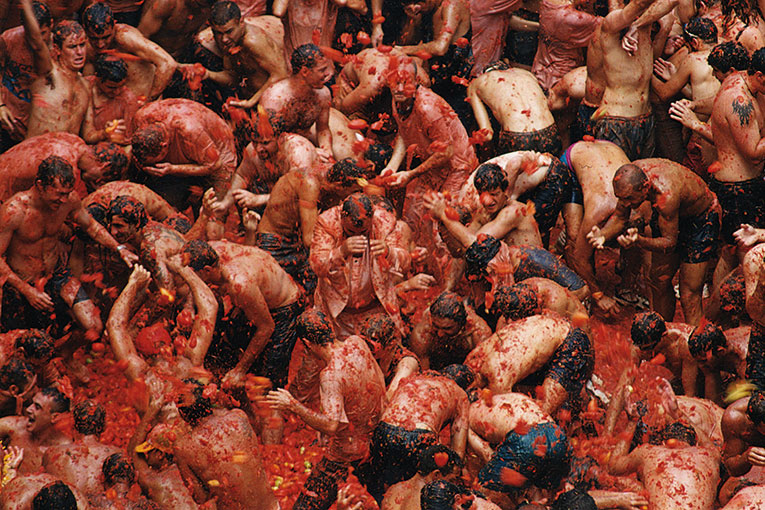
|
To trace the evolutionary origins of festive celebrations as specific forms of ritualistic interactions, we will pinpoint the repertoire of festive activities (playing, singing, dancing, music making…) at a specific point in the humanisation process, after group size increased. Then, we will go on to analyse its «cradle» or constitutive milieu and identify its social effects. And finally we will identify the specific function of festivals, which is the construction and internalisation of oneness1. Of all institutions peculiar to mankind, few are so appealing and yet seem so inconsequential as festivals. In fact, humans are the only living beings to hold festivals, yet festivals are defined as purely futile activities, idle and gratuitous, without practical value. Believed to be quite the opposite, they are unproductive, consume too much time and energy, too many resources, so much so that the grim sticklers censor with disapproval those who engage in the frenzied delight of cultivating festivals, as we have done in the Mediterranean since time immemorial. This poses the question of whether festive-makers are mad, or at least irrational, given we celebrate something as seemingly dysfunctional as festivals. Here we will trace these celebrations back to their biological foundations, in the light of the latest research into palaeo-anthropology, archaeology and psychology, endeavouring to identify what could be the ultimate adaptive advantage this trait contributed to the humanisation process, when the Homo sapiens lineage broke away from related great apes and other primates, which resembled us but lacked any inclination towards festiveness. |
«Humans are the only living beings to hold festivals, yet festivals are defined as purely futile activities, idle and gratuitous, without practical value» | |
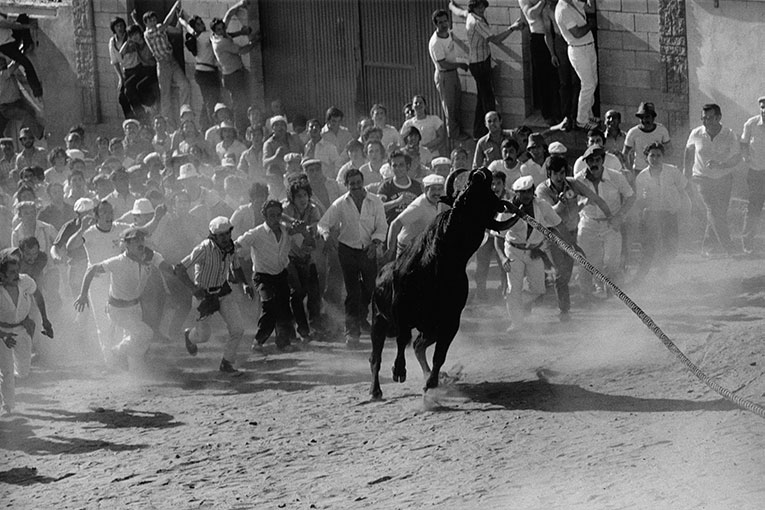 Cristina García Rodero / Magnum Photos Cristina García Rodero / Magnum PhotosCristina García Rodero. The Bull (Benavente), 1980. «Hidden Spain» collection. Photography, variable dimensions. |
||
|
Festive genes A relevant clue to reconstructing the biological origin of festive behaviour is provided by Robin Dunbar (renowned British evolutionary psychologist), author of a book published in 1998 entitled Grooming, Gossip and the Evolution of Language. Here he hypothesised that human speech, 80% of which is devoted to social chitchat or gossip, functionally replaced grooming, namely body-cleansing activities (grooming and delousing), which primates engage in to reinforce closeness and cohesion. Indeed, 80% of primates’ time budget is devoted to the practical needs of subsistence, like sleeping and eating or escaping from predators, but mostly to seeking and gathering food. The remaining 20% is spent on socialising, a large part of which involves body grooming of offspring, mates and other subjects with whom ties of mutual support are established. Because grooming –a way of pampering and caressing others physically– releases endorphins (body-made opiates), it is this practice that psychologically relaxes group members most, thereby reinforcing their social ties and bonds. Hence, grooming acts like the group’s cement, strengthening social cohesion. It was the adaptive advantage of bonding that led to the positive selection of primate groups that practised it, while those that did not were less able to adapt successfully. Now, grooming, like sexual foreplay with which it is related, is an exclusively bilateral affair that can only be performed in pairs: a female with her offspring, one primate with another, and so on. Hence, it can only serve as social cement in small groups, such as groups of primates that do not exceed a few dozen members, where everyone can relate to each other by grooming. But when the group size grows, grooming can no longer serve to create social cohesion. For a group exceeding fifty members, the time spent grooming others would surpass 30% of the total time budget, which would not leave enough time to be devoted to foraging effectively. For this reason, on the growth of group size, new instruments of social cohesion had to be invented. Thus arose speech, chatter, chat, conversation, gossip: a choral group activity, no longer bilateral but multilateral, enabling multiple bonds of social cohesion to be forged among all group members. All this made the emergence of language possible little more than 500,000 years ago, at which time hominid group size grew from less than fifty to over one hundred members, who could relate to one another through a common language. However, in a more recent work, Robin Dunbar himself extended this finding to other means of social relationships that emerged during the humanisation process in parallel with language. Here, above all, laughter stands out (nonexistent in primates): humour, games, jokes, revelry. But also dance, rhythm and song, especially group singing. And from there, music, as documented by the British palaeo-archaeologist Steven Mithen in his book on the origins of music and language: The Singing Neanderthals sparked by the oldest flute fossil discovered, dated to some forty thousand years ago. So it turns out that (good) humour, games, dancing and music are all corporal forms of nonverbal communication, which have the same consequences as body grooming. They release endorphins, relaxing minds greatly, generating waves of carnal gratification and strengthening interpersonal bonds among all participants, bringing them together and raising group cohesion. All of this is dramatically enhanced if we add the intake of doping substances like exorphins (external drugs), or any other group sociability stimulants like alcohol, tobacco, coffee, marijuana, and so on. |
||
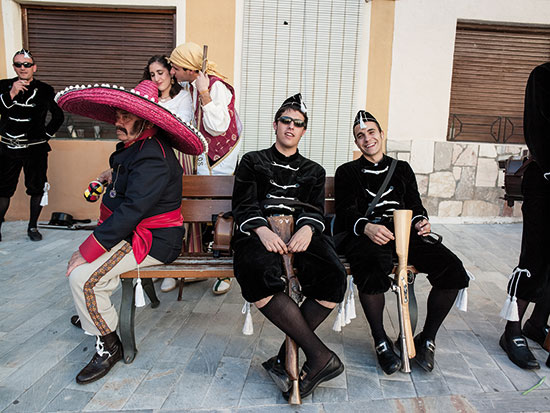 Mario Rabasco Mario RabascoHumour and eroticism are essential ingredients of festive sociability. The photograph shows participants in the Ball dels Espies in Biar (Alicante), a humorous ritual dramatisation of the Moors advancing into Christian territory, conquered during the festivals of Mare de Déu de Gràcia (May), in which couples in fancy-dress participate. |
||
|
The cradle of festivals So here we have all the ingredients for festive behaviour, whose cradle is the ritual generating collective excitement. The latter concept, proposed by the founder of sociology, Emile Durkheim, has now been ciphered by the American sociologist Randall Collins in his «interaction ritual chains». For festive behaviour to ensue, several people –preferably more than two– must get together (it is debatable whether family rituals may be considered «festivals»), who congregate in circumstances defined by barriers of separation, both in terms of space and time: inside or outside the festival, before and after the festival. Once inside the festive space and once the festival has started, those congregated pursue a number of practices (singing, dancing, contests, competitions, libation, commensalism…), which are linked by their common reference to a single focus, coinciding with the celebration of the festival itself. And these practices produce transient sensory stimuli in the gathered members that reverberate (which the Collins dictionary defines as «to reflect or be reflected many times»), thus creating feedback or Durkheim’s «collective effervescence». The effects arising from festive celebrations involve each individual participant as well as the group as a whole. With respect to the group, there is an intense strengthening of cohesion and collective solidarity, identified with certain «sacred objects» (ritual events like the running of the bulls, the fire consuming the fallas, and so on), which symbolise the superhuman power (albeit supra-individual) of the collective experience. As for the participants, their involvement grants a sense of personal exaltation, they reach outside themselves, exceeding their usual bounds to attain a level of personal fulfilment that they could not achieve otherwise. At the same time, a kind of festive patriotism is achieved whereby the participants identify with the collective oneness, as sense of belonging generated by the festival (we will come back this concept of oneness later), to which they attribute the highest moral authority and ardently defend any attempt to ignore, devalue or deride it. |
«Robin Dunbar hypothesised that human speech functionally replaced grooming, namely body-cleansing activities that primates engage in to reinforce closeness and cohesion» | |
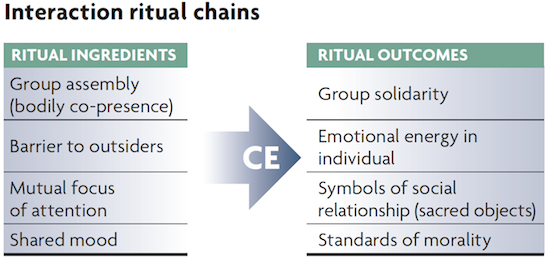 Source: Adapted from R. Collins, 2009, p. 72 Source: Adapted from R. Collins, 2009, p. 72The concept of «collective effervescence» (CE) was proposed by the sociologist Emile Durkheim and later included by Randall Collins in his interaction ritual chains. |
||
|
Ritual for ritual’s sake There are many types of ritual interactions, notably the most complex being liturgies, which are forms of religious rites, whose sacred objects (symbols of social relationships) are attributed to the supernatural. And here we can consider the usual rhetorical question: which came first, religion or festival? With respect to religious rituals, we know from the date of preserved burials –as signs of death cults– that the oldest cannot exceed the 40,000 years dating the aforementioned flute. However, this fact does not help us much, because most festivals do not necessarily leave any fossilised footprints, and the fossil remains of instruments could be a testimony of either festive rituals or other routines (hunting, fishing, gathering…) or of other practical behaviours. Laughing, dancing, games, songs, rhythmic parades, clapping in unison, and so on, leave no trace. Hence the difficulty in distinguishing the secular celebration from the sacred liturgy, as well as distinguishing festive rituals from routine practices. All the more so when you consider that most ritual activities could result from the routinisation of work habits. For example, singing in chorus could have arisen from synchronising and pacing the gait of groups marching across country, or in military training, hunting parties or public parades. It may also have been useful to prepare hunting parties, delegating positions and tasks by cooperative ritualised practices. And, likewise, many festive ceremonies could have arisen from contagion of family rituals (weddings, baptisms) or the celebration of religious cults (burials). So, festivals, games, work, religion, magic, hunting, fishing, family, and so on, together formed a continuous ritual, making it difficult to distinguish specific differences. How then can we isolate the specific festive gene? One possibility is to consider that this is not just a ritual (interactive habitual practice) but also an institution. And as Searle tells us, institutions are defined by their «status functions», defined as «collective assignment of a function to entities that could not fulfil the function without that assignment» (Searle, 1995). For example, the status function of religious ritual is to summon the gods or the dead. Put roughly, hunting rituals serve to promote good hunting and religious rituals serve to placate the gods, making them benevolent and propitiatory. So far, so good, but what is the function assigned to festivals? What status function does the community assign? This question has two possible answers. The first is that festivals are pointless beyond and above the celebration in itself. It is the practice of ritual for ritual’s sake, without any ulterior purpose. It is a way of saying that festivals are not utilitarian rituals, they are not functional, nor do they serve to promote hunting or facilitate work, nor to summon the gods or to celebrate the growth of the family… This answer is based on the negativity of festivals, their breaking any dependence on other institutions to conquer thus full autonomy. Festivals are celebrated for their own sake, without apparent reason or cause. This emphasises the radical sociality of festivals, which separates their rituals from any natural, practical or physical functionality that their component activities may have. Thus, festive commensalism separates eating from any functionality related to nutrition that food may have in itself and rather relates to the simple act of eating together. All this is according to Searle’s definition of an institution: collective attribution of a social function that is independent of the physical properties of the activity in question. |
||
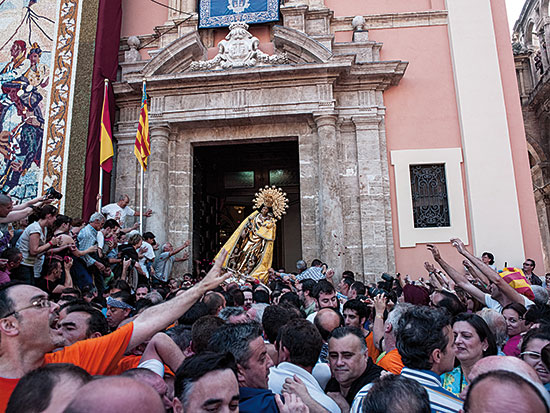 Mario Rabasco Mario RabascoFestivals produce an effect of collective solidarity, identified with certain sacred objects. The image shows the Mare de Déu dels Desemparats being carried through Valencia (May), stirring up a strong feeling of exaltation linked to local identity through a religious symbol. |
||
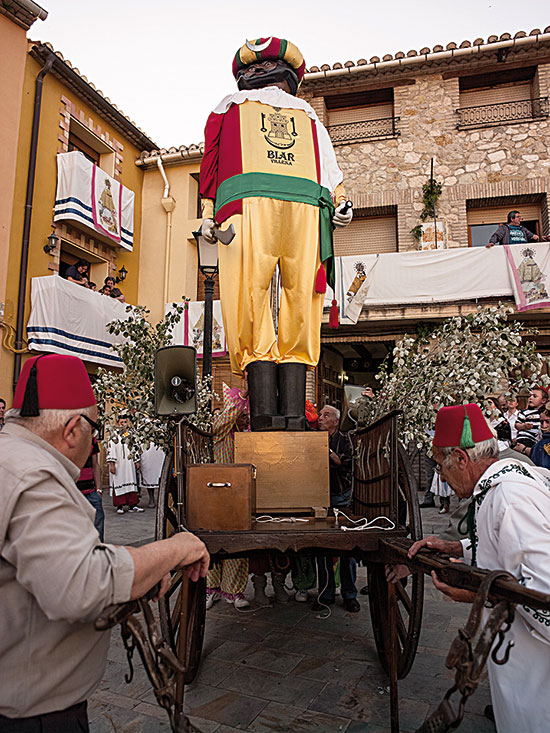 Mario Rabasco Mario RabascoSocial groups acquire a sense of belonging, a state of oneness, through festivals, allowing collective identification as a distinct group. The image shows Mahoma de Biar (Alicante), a key figure in the dramatisation of the battles between Moors and Christians, performed during the celebrations in honour of the Mother of God, Mare de Déu de Gràcia, who wears the name of the village on her robes. |
«Good humour, games, dancing and music are all corporal forms of nonverbal communication, which have the same consequences as body grooming» |
|
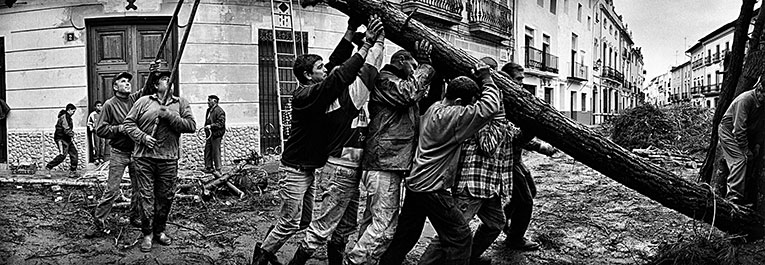 Mario Rabasco Mario RabascoOrganising festivals involves cooperation, strengthening the sense of belonging. The illustration shows a group of men preparing the bonfire to celebrate San Antonio in the town of Canals. |
||
|
Acquiring oneness And now we come to the second answer to the question posed above. The status function that the community assigns to festivals, regardless of the functional effects of constituent activities, is to create the aforementioned oneness, redefining the individual self of each of its participants to recreate them as part of a supra-individual «we». This is what Searle calls «collective intentionality» which occurs when a transcendent «we-intentionality» emerges from the union of individual or «I-intentions» (Searle, 1995). Raimo Tuomela also speaks of «We-intentionality» while Mike Tomasello refers to «shared intentionality» in the same sense as Searle. And this was the adaptive advantage that the institutionalisation of festivals conferred to Homo sapiens during the humanisation process: to bestow a new shared intentionality, which enabled them to overcome the contradictions arising from conflicting inter-individual reciprocity. Research by evolutionary psychologist Mike Tomasello, comparing interactive learning of chimpanzees or human children of preschool age, clearly demonstrates that our species is capable of assuming a shared intentionality once subjects have reached an awareness of being a part of «we» (something chimpanzees do not manage), an experience that is learned by participating in cooperative interaction. This is possible through practical activities like hunting or work, where the interaction is at the service of physical efficacy. But it is also learned through recreational activities like singing, dancing, games, festivals: situations in which these interactions are at the service of collective solidarity, and no longer at the service of physical or practical performance. This is true especially in the case of festive behaviour, the only ritual activity which seeks nothing more than the cult of oneness, the cradle of social cohesion. This may well make us think that the festival, as an institution, was both necessary and sufficient for all other ritual celebrations to become institutionalised thereafter. This was the great adaptive advantage that allowed us to evolve, institutionalising all other cultural experiences based on shared intentionality. 1. Nosotridad in Spanish. Term coined by Ortega y Gasset. Other authors call it nosidad. (Go back) |
||
REFERENCES
Collins, R., 2009. Cadenas de rituales de interacción. Anthropos. Barcelona.
Dunbar, R., 2007. La odisea de la humanidad. Una nueva historia de la evolución del hombre. Crítica. Barcelona.
Mithen, S., 2007. Los neandertales cantaban rap. Los orígenes de la música y el lenguaje. Crítica. Barcelona.
Searle, J., 1997. La construcción de la realidad social. Paidós. Barcelona.
Tomasello, M., 2010. ¿Por qué cooperamos? Katz. Barcelona.
Tuomela, R., 2000. Cooperation. Kluwer. Dordrecht, NL.





